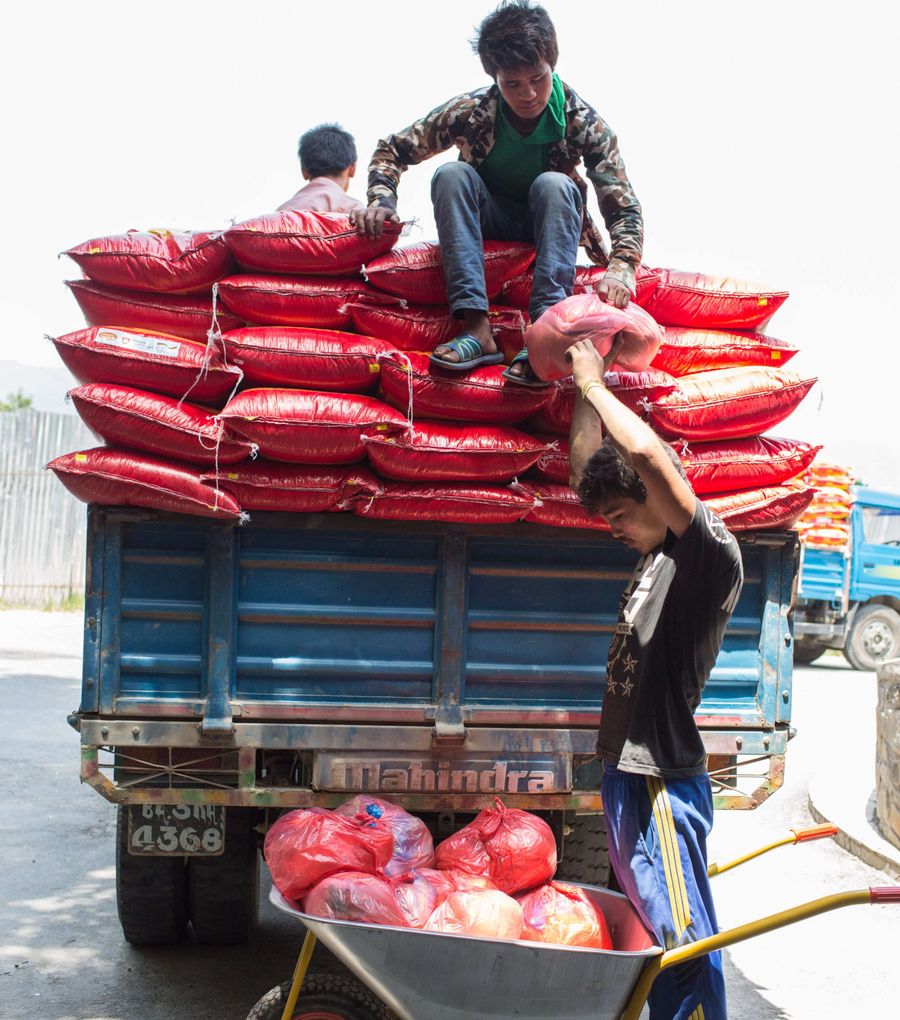Emergency relief: Providing aid in Nepal’s hour of need
On Saturday April 25, 2015, a violent and shallow earthquake of magnitude 7.8 strikes Nepal at 11:56 local time. Within minutes, international aid organizations around the world receive automated alerts, and the governmentof Nepal calls for international assistance. Staff at Malteser International's HQ contact local and international partners, and begin response procedures. Malteser International experts in Cologne, Haiti and Thailand head to the stricken country...
Planning for the unthinkable

Emergency relief missions are probably what comes to most people’s minds when they hear the words ‘humanitarian aid’, or ‘disaster relief’. Understandably, the dramatic and often dangerous moment when a group of international specialists flies in to a stricken country to provide aid in the wake of a major humanitarian disaster is frequently a major focus for the attention of the public and the world’s media. However, emergency missions are actually just one part of a much bigger process.
To be able to do their job during the crucial period following a disaster, aid workers draw on years of training and preparation, as well as the support of teams of people working behind the scenes to make sure that they have the information, the techniques, and the tools that they need at hand. Extensive planning and coordination are essential to ensure that the right aid gets where it needs to be. In this report, Oliver Hochedez, Malteser International’s Emergency Relief Coordinator, gives an insight into the challenges of providing urgent aid at the scene of a major humanitarian catastrophe:
Our approach: building partnerships and local capacities
"At Malteser International, we see emergency relief as part of a cycle that requires long-term engagement in vulnerable countries. Emergency operations work best, and are most sustainable, when they are part of an ongoing commitment to strengthening local infrastructure both before and after disasters. Working with local partners, such as governmental authorities, or local medical and aid organizations, is a key element of this strategy. Locals are always the first responders in disaster situations, and working with them allows us to draw on their much wider range of knowledge, networks, and infrastructure. By strengthening and supporting our partners, we can ensure that local communities are better prepared for disasters in the future, and that they continue to benefit from our work long after our projects have finished.
The value of this approach was illustrated during our relief efforts following the earthquake in Nepal. We first began working to improve disaster preparedness amongst flood-prone communities in the south of the country in September 2012 by cooperating with local partners to set up an early warning system, and to protect water sources from contamination by floodwater. This meant that Malteser International’s teams arrived in Kathmandu with contacts, a base, and support system already in place, and that they could make the most of the crucial hours and days following the earthquake.
Local knowledge, global reach

In addition to our local partners, our international and global alliances are crucial. Working with international coordinating bodies like the UN provides essential help with planning and assessment, and helps us to make sure that our aid arrives where it is needed most during emergencies. Adhering to international benchmarks such as the SPHERE guidelines, and the international Core Humanitarian Standard helps us to make this aid as effective as possible.
As the Order of Malta’s international aid agency, we are also able to draw on the Order’s unique worldwide network. This provides us with rapid and flexible access to personnel and logistical support in disaster situations. In Nepal, the Malteser International emergency response team was composed of a highly qualified and very experienced group of doctors and paramedics from this network. Several of them had been part of the Malteser International response to the major earthquake in Haiti in 2010, and had provided aid in the wake of a variety of other humanitarian catastrophes around the world. Less than two days after the earthquake struck, over half a ton of medication was awaiting a flight to Kathmandu – transported by the Order of Malta’s German volunteer service, sourced from our partner action medeor, and dispatched on a flight specially chartered by ADH – a coalition of relief organizations.
On the ground: care for mind and body
As an organization of the Order of Malta, we are part of one of the world’s strongest and oldest traditions of providing medical care. Health projects are our main area of activity, and our core competence is improving the health of people in need. Our approach to health emphasizes the need to take a holistic approach by protecting health through good nutrition, and the provision of clean, safe water and hygiene; as well as considering the mental health of people affected by disasters. Arriving in Nepal, our team provided medical treatment to sick and injured people, as well as psychosocial support to some of the vast number left heavily traumatized by the experience of losing their homes, families and livelihoods.
Urgent action was needed to ensure that the 2.8 million who had lost their homes had somewhere to sleep, and to supply the hundreds of thousands left without food or water. Sickness can spread quickly in the appalling conditions that prevail following a disaster. In the days after the earthquake, and again in November – as winter began to bite, and a blockade prevented supplies crossing from India – the efforts of our team to provide tarpaulins, hygiene kits, medical supplies, and winter relief material for over 70,000 people was life-saving.
The aftermath: building back better

The job of disaster relief organizations is to make themselves obsolete. By raising the standard of disaster preparedness in vulnerable countries, and strengthening the ability of local organizations to respond to future crises, we hope to make it possible for vulnerable nations to take control of their future, and respond to disasters without outside help. In the most severely earthquake affected areas of Nepal, local building styles proved highly vulnerable to tremors. From the very first, Malteser International-supported rebuilding efforts sought to ‘build back better’. We erected earthquake resistant model houses for the most vulnerable members of the community, and used these houses to train others in safer building techniques. We then gave them the materials and support that they needed to build new homes for themselves.
Because of Nepal’s mountainous terrain, and the damage to roads caused by the earthquake and the rains that followed, communication and transport in the country ground almost to a halt. For sick and injured people in isolated regions needing medical treatment, this was disastrous. By collaborating with existing medical structures at Dhulikhel hospital, we were able to step in to fill the gap faced by local medical staff. In cooperation with the hospital, we brought medical aid to people in need in outlying areas, who would otherwise have been unable to access it, by establishing a Basic Health Unit at Lamosanghu, to treat patients in remote villages near to the Chinese border. With a three-month supply of medication on hand, this field hospital was able to continue to operate even when landslides blocked the roads. By coordinating with other aid organizations in the area, we have been able to ensure that locals will continue to have access to high quality treatment in the years to come.
The future
The so-called emergency relief phase of Malteser International’s work in Nepal only lasted around three months but, together with our partners, we will continue to provide aid in the country for years. The construction of three new permanent health stations in outlying mountain regions will be amongst the first steps towards returning local communities to an acceptable standard of living. Building and repairing water and hygiene systems, as well as helping locals to overcome their trauma and improve their preparedness for future disasters, will continue to be major focuses of our work."
Read more about our work in Nepal
- Taken from the Malteser International Annual Report, June 2016

Timeline:
Day 1
More than half a ton of medical supplies are packed for Malteser International, to be dispatched to Nepal on a flight specially chartered by our partner organization ADH.
Day 2
The Malteser International team arrives in Nepal, and begins providing aid to the heavily traumatized survivors. The airport in Kathmandu is small and damaged, limiting the amount of aid arriving. Some aircraft need to be turned back in flight.
Day 3
Additional Malteser International experts arrive in Kathmandu, and begin providing aid in the outlying regions of Gorkha and Dhulikhel – supporting medical facilities and distributing shelters, hygiene kits, and medical supplies.
Week 2
Malteser International begins distributing five tons of food, blankets, tarpaulins, and hygiene articles in the Khavre district, northeast of Kathmandu.
May 12
A second earthquake strikes, with magnitude 7.3, and its epicenter in Malteser International’s area of activity, causing further injuries, deaths, and building collapses.
Week 3
Malteser International establishes a Basic Health Unit at Lamosanghu, near to the Chinese border, in collaboration with Dhulikhel Hospital, and continues to provide food to the local population.
Three months
The emergency phase of Malteser International’s work is officially over. The focus of relief efforts shifts to reconstruction. Rubble clearance activities intensify: roads and public spaces are opened again, and areas are cleared for rebuilding. Malteser International constructs model houses with strong foundations for people in the greatest need, and helps locals rebuild by providing expertise and materials.
Six months
Political tensions lead to a blockade at the Indian border with Nepal. Fuel and aid materials are unable to enter the country. Despite difficulties, Malteser International continues its work, as well as carrying out an emergency winter relief program: providing insulation, clothes, and stoves to help vulnerable people living in the mountains to keep warm.
One year
Rebuilding efforts continue. So far, we have constructed houses for 822 highly vulnerable people, using techniques that will make them resistant to future disasters. We have provided nearly 12,000 others with materials and help to do the same for themselves. The Malteser International Basic Health Unit, which treated around 9,000 people in the 12 months following the disaster, continues to operate.
In total, the disaster cost 8,699 people their lives, wounded more than 22,000, and left around 2.8 million without a home.









